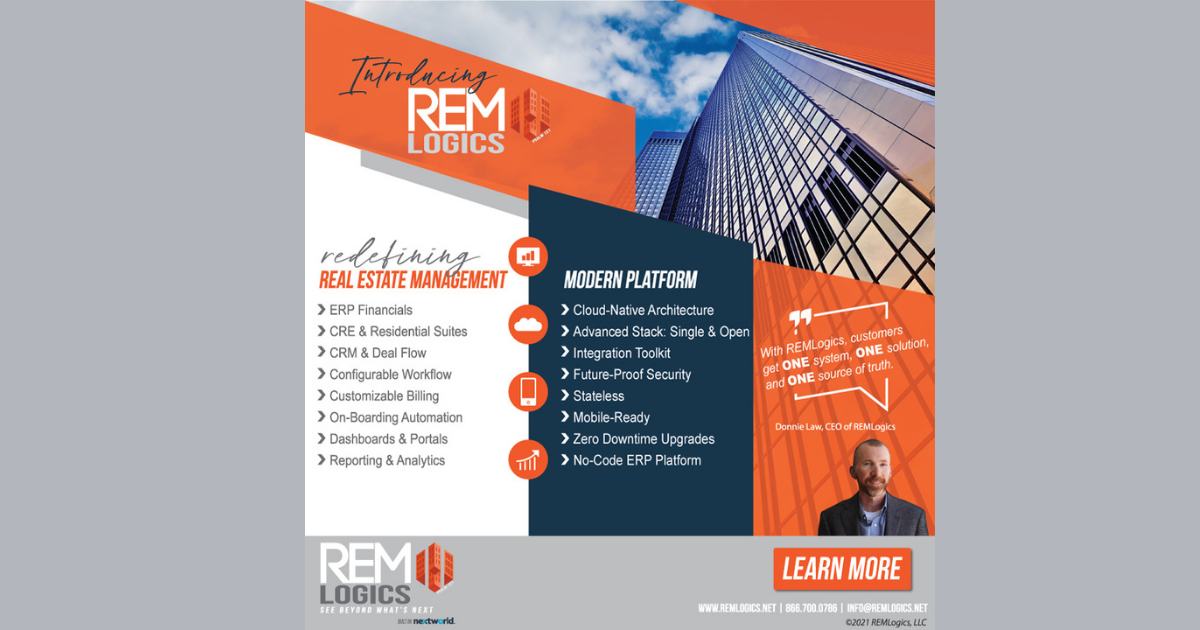Revisit Your Technology Architecture
Kylee McVaney, CEO, Nextworld

Digital transformation has been a buzzword since the mid-2000s. It was primarily lip service and a concept that was included in future roadmaps but not next year's budgets. The pandemic rocked the world and changed everything. There is now no such thing as "business as usual."
What is real estate management digital transformation? Leveraging technology, it is putting tenants at the center of the universe and defined by specific business outcomes. It is capturing new revenue streams and markets. It is using technologies that differentiate the way products and services are delivered and supported. It is delivering digital operational infrastructure services such as analytics, reporting, and mobility, to enable agility and foster innovation across the organization.
Many companies are taking a hard look at where they now stand, how they got there, and where they want to focus next. As part of this introspection, executives are realizing technology truly is crucial and imperative for their business success.
There are three reasons to revisit your current technology architecture to become more agile, to use technology strategically, and to achieve a more flexible cost structure.
1. Agility Wins
What became clear to many executives is most successful companies had adopted digitalization prior to 2020. First-moving companies saw the value of implementing modern technology that can "move with the business." As a result, they coped better with the pandemic challenges than those that didn't. Leaders in other industries were flexible and able to acknowledge and accept reality as it was. They quickly adapted to address these new challenges.
- Red Roof hotels began booking rooms as a daily workspace and now find themselves as a challenger in the co-working market.
- Walmart’s investment in automation and innovation accelerated onboarding new employees to less than 24 hours. They launched a new warehouse management system in days — instead of months — to fire up a new distribution center.
- Starbucks used its technology to create a seamless new workflow for baristas and deployed new espresso machines that could predict necessary maintenance.
- Rolls-Royce redesigned its entire supply chain, secured new parts, orchestrated operations, and within five weeks was building ventilators.
Technology enabled these quick pivots. These companies not only survived, but they are also thriving. According to McKinsey & Company's 2020 Global Survey of executives, "companies have accelerated the digitization of their customer and supply-chain interactions and of their internal operations by three to four years."
In the real estate industry, forward moving real estate companies are now prioritizing and accelerating their digital transformation initiatives. This requires the ability to overcommunicate to both make sure they fully understand everyone in their ecosystem and to help protect employee and tenant relationships.
2. Strategic Technology Architecture Determines Success
Our years of experience in real estate management ERP have made it clear that core systems can either accelerate business performance or significantly limit it. New research confirms it. In its Technology Vision 2021 report, Accenture surveyed business and IT executives from 31 countries and 14 industries. It found that technology is crucial to mastering change. From the report:
- 77% of executives stated that their technology architecture is becoming critical or very critical to the overall success of their organization.
- 83% of executives report that business and technology strategies are becoming inseparable.
- The top 10% of companies leading technology innovation achieved 2-3x revenue growth as compared to their competitors.
For years, we've seen real estate companies trying to address employee and tenant needs with rigid tools and processes. In most cases, fixing these problems require an immense IT effort, and we know IT teams are already stretched to capacity. An agile technology architecture that separates business applications from the underlying technology offers the agility to address sudden market shifts that alter your competitive landscape.
Accenture calls this separation "Bring Your Own Environment." No-code ERP platforms and applications allow business experts to optimize their processes or fix problems on the fly, without needing advanced technical skills or compromising IT governance. Applications built on a no-code ERP platform can easily add capabilities and adapt processes. They can do it without introducing compatibility, security, or integration problems and they don't need ongoing professional services engagements just to stay current.
3. Cost Structure Aligned to Strategic Needs
Traditional and legacy technology ties up money. Real estate management ERP systems alone typically cost millions of dollars in maintenance, support, monolithic licensing structures, and consulting services just to maintain the status quo. Deloitte notes that only 19% of a company's IT budget goes to innovation - “the lion's share of the budget goes to keeping the lights on. Does that sound like a good idea to you? Given a choice, what company would agree to that?”
Cloud SaaS models have already slashed the costs of legacy systems for many companies. Cloud-native, no-code ERP platform and applications deliver much more than just cost savings. They offer:
- Technology architectures that increase agility.
- Continuous business innovation. Companies can pivot and take advantage of new opportunities much easier and faster.
- Ability to fund more viable opportunities.
- Maximize the talents of people investments, especially in the face of global software developer and technical talent shortages.
A modern, no-code ERP platform make it easier for companies to inspire their people and foster innovation across the entire organization.
How to Thrive in 2022 and Beyond
A no-code enterprise application platform helps companies leapfrog generations of legacy technology to bring their vision of the future to reality. Evolving and updating your technology architecture can increase innovation, improve adaptability, and ultimately increase revenue while providing needed cost savings. This strategic process helps free companies from costly software maintenance, expensive consultants, disruptive updates, and future talent acquisition concerns. REMLogics and Nextworld are redefining Real Estate Management ERP.
This Week’s Sponsor
We help customers See Beyond What’s Next with cloud-native ERP real estate management solutions for office, retail, industrial, and residential owner operators. REMLogics is built on a modern no-code ERP platform so customers can continually innovate and respond faster to the ever-changing real estate and technology landscape. To learn more visit www.remlogics.net.
Read Next
 5/29/2025
5/29/2025
AI Can’t Fix Bad Data. These Ideas Can Get You on the Right Track. Real estate visionaries constantly integrate innovative technology to make their organizations more efficient.
 5/22/2025
5/22/2025
Managing Building Automation and Integration Like an Investment Portfolio What if your building automation and integration decisions were managed with the same precision, discipline, and long-term vision as Warren Buffett’s investment portfolio?
 5/15/2025
5/15/2025
Tech, Talent and Transformation: 2025 Digie Finalists Announced For 27 years, Realcomm has presented the Digie Awards to acknowledge companies, real estate projects, technologies, and individuals that have advanced the commercial real estate industry through the strategic use of technology, automation, and innovation.
 5/15/2025
5/15/2025
Empowering Space Management with Data-Driven Visualization For effective CRE space management, it’s critical to centralize lease data, maximize rental square footage (RSF), improve energy efficiency and reconfigure spaces to meet changing needs.


%20(1)%20(1)%20(1).png)













